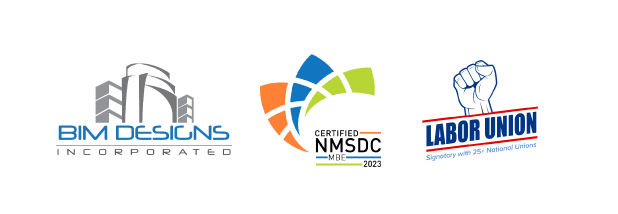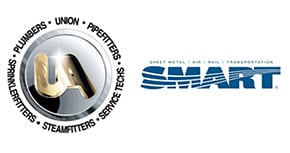Construction Terminologies
Explanatory symbols, objects or notes which add information to a drawing.
An amalgamation of architectural, mechanical, and other existing design files that represent site conditions. Background models may have pre-existing systems in them, and may be useful for coordinating new designs.
Building Information Modeling is a process supported by various tools, technologies and contracts involving the generation and management of digital representations of physical and functional characteristics of places.
Is an intelligent 3D model-based process that gives architecture, engineering, and construction (AEC) professionals the insight and tools to more efficiently plan, design, construct, and manage buildings and infrastructure. During the coordination process trades collaborate to resolve collisions and ensure clean functional routing for all systems.
Is the technique of identifying if -- and where or how -- two parts of the building (e.g., plumbing, walls, etc) are interfering with one another.
Is an instance that occurs when sections of a 3D model intersect. Collisions are hazards that AEC professions encounter when constructing a building and are resolved during the collaboration phase of a project.
A term used in project management to describe a tangible object produced as a result of the project that is intended to be delivered to a customer (either internal or external). Most deliverables are in the form of a functional model, shop drawings, or spool drawings.
Someone one who prepares detailed plans, drawings and other documents for the manufacture and erection of steel members (columns, beams, braces, trusses, stairs, handrails, joists, metal decking, etc.) used in the construction of buildings, bridges, industrial plans, and nonbuilding structures.
A method of tracking and identifying duct spools for the fabrication shop and field. Ducts are typically assigned a unique number, job location (floor/room) and a basic representation of the duct shape may be placed next to other identifying information to reduce treasure hunts by the field.
A raised concrete, or other material, surface to protect equipment from flooding and provide additional elevation for gravity drains.
Detailed and dimensioned drawings that provide the field with the information necessary to fabricate and install hangers at specified locations and elevations.
The Internet of things (IoT) is a system of interrelated computing devices, mechanical and digital machines provided with unique identifiers (UIDs) and the ability to transfer data over a network without requiring human-to-human or human-to-computer interaction.
Devices mechanical equipment is placed on to help reduce vibration and noise transmission.
Journeyman is a worker, skilled in a given building trade or craft, who has successfully completed an official apprenticeship program typically lasting at least 10,000 hours between classroom instruction and on the job training with qualified journeypersons as mentors.
Also known as high-definition surveying (HDS) or reality capture, is a means of using a laser to map an area with high accuracy. On a construction site, laser scanning is used to capture detailed data, providing accurate information for every nook and cranny on a site.
LEED (Leadership in Energy and Environmental Design) is the most widely used green building rating system in the world. LEED provides a framework for healthy, highly efficient, and cost-saving green buildings.
File type is primarily associated with Profile Master 2000 which is an autocad software used by some fabrication shops to help automate the cutting of sheet metal and final construction of the spool.
Detailed reference table that delineates size, style, and type of piping, duct, or fittings and where they are to be used on a project.
Mechanical Electrical Plumbing and Fire: refers to these aspects of building design and construction.
Transfer of an existing model, or legacy file, to one that is functional for current software.
Process and instrumentation diagram; it gives piping sizes, gauges, and fittings
Finalized plan drawings prepared for submission to a governing agency for the purpose of receiving a building permit.
A pattern of small, distinct dots created by a 3D laser scanner to scan an area’s measurements. The data collected from these are measurable and can be combined to create a near photo-realistic model of actual site conditions.
Reflected Ceiling Plan Drawings is a drawing of a room or space looking down at the interior ceiling. Useful for modelers to help establish ceiling height and potentially lighting/fire safety locations.
RCP file type is appended to Navisworks to view point clouds from Laser Scanners.
Is a BIM (Building Information Modeling) software tool that was developed in 1997 and acquired by Autodesk in 2002. Revit is focused more towards construction with tools for engineers and architects, along with better functionality for piping and ductwork. It is less convenient to provide deliverables from Revit by comparison to AutoCAD at this time.
Collection of files organized into logical groups such as valves, duct, piping, etc...that have accurate design and dimensions used to populate the model with the correct information. Essentially a database of parts for Revit.
A request for proposal (RFP) is a business document that announces and provides details about a project, as well as solicits bids from contractors who will help complete the project
A diagram (two-dimensional, in a vertical plane) which shows the major items of electrical equipment in a building; displays, floor by floor, the feeders and major items of equipment.
Additional hanger information, designed and provided by qualified engineers, to ensure the piping and ductwork can withstand seismic events.
Placement of seismic bracing (see below) into the model.
Is the manufacturer's or the contractor's drawn version of information shown in the construction documents. The shop drawing normally shows more detail than the construction documents and can be used by the field to aid with fabrication and/or installation.
Creation of the exterior elements of a building including grade and potential landscape.
is a means of access through a material for a pipe, a conduit, wiring, etc. Ideally, sleeves are designed prior to concrete pour to reduce the need for cutting of walls or floors after the fact.
A written document describing in detail the scope of work, materials to be used, methods of installation, and quality of workmanship for a parcel of work to be placed under contract; usually utilized in conjunction with working (contract)
A plan view of the assorted spool drawings showing their order and location relative to predetermined points within the construction site such as column lines or walls. Spool maps may often include elevation changes. Well designed spool maps should facilitate the installation of any spool without having to to work from one end or the other.
Detailed portions of a piping or duct project focused on providing the fabrication shop the necessary information to construct the piece. Spool drawings are dimensioned and oftentimes have more than one view of the segment for easy reference.
Are shop drawings, material data, samples, and product data. Submittals are required primarily for the architect and engineer to verify that the correct products will be installed on the project.
An electronic/optical instrument used for surveying and building construction. This system provides the field with very accurate information to ensure the BIM model is easier to implement. Field personnel use data from the BIM model to establish key points in the field that correspond to hangers, piping, equipment pads, etc.
Virtual Design Construction is a service that uses digital tools to create virtual models of buildings. These digital models.
Virtual Design Construction Tech a person who uses CAD modeling software to populate a model or create deliverables.



